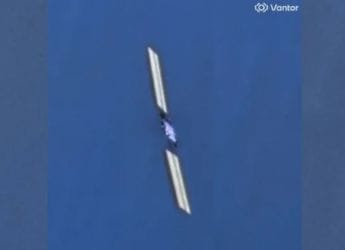- Home
- Science
- Science News
- Earth to Capture an Asteroid as Second Moon Temporarily This Weekend, NASA Confirms
Earth to Capture an Asteroid as Second Moon Temporarily This Weekend, NASA Confirms
Earth is set to capture a temporary second moon, asteroid 2024 PT5, on September 29.

Photo Credit: NASA/ JPL
Earth will gain a "second moon" at 1954 UTC on Sunday, September 29
NASA scientists have determined that Earth will capture a second moon on Sunday, 29th September 2024. This small asteroid, named 2024 PT5, typically orbits the sun as part of the Arjuna asteroid belt. Unlike our long-term lunar companion, which has orbited Earth for over 4 billion years, this temporary second moon will only stay with Earth for a matter of weeks, leaving by 25th November 2024. Carlos de la Fuente Marcos, a professor at the Universidad Complutense de Madrid, confirmed the asteroid's brief stay in a recent report to Space.com.
What is Asteroid 2024 PT5?
Asteroid 2024 PT5 is part of the Arjuna asteroid belt, a small group of space rocks that follow orbits similar to Earth's. These asteroids typically travel at a relatively slow speed of less than 2,200 miles per hour, allowing for closer approaches.
During this period, 2024 PT5 will approach Earth at a distance of about 2.8 million miles. However, unlike the moon, it will not complete a full orbit around our planet.
A Rare but Expected Event
Gravitational captures of this kind, where small objects are temporarily caught in Earth's orbit, are relatively common, occurring several times each decade. While this might sound surprising, many such asteroids come and go without drawing attention. Previous similar events have lasted only a few weeks, and sometimes even years, depending on the asteroid's trajectory.
Observing 2024 PT5
Though the concept of a second moon is intriguing, asteroid 2024 PT5 will not be visible to the average skywatcher. Measuring only 37 feet in diameter, it is vastly smaller than the moon, which is over 2,100 miles wide. Marcos noted that only professional astronomers with specialised telescopes could observe this asteroid.
Get your daily dose of tech news, reviews, and insights, in under 80 characters on Gadgets 360 Turbo. Connect with fellow tech lovers on our Forum. Follow us on X, Facebook, WhatsApp, Threads and Google News for instant updates. Catch all the action on our YouTube channel.
Related Stories
- Samsung Galaxy Unpacked 2025
- ChatGPT
- Redmi Note 14 Pro+
- iPhone 16
- Apple Vision Pro
- Oneplus 12
- OnePlus Nord CE 3 Lite 5G
- iPhone 13
- Xiaomi 14 Pro
- Oppo Find N3
- Tecno Spark Go (2023)
- Realme V30
- Best Phones Under 25000
- Samsung Galaxy S24 Series
- Cryptocurrency
- iQoo 12
- Samsung Galaxy S24 Ultra
- Giottus
- Samsung Galaxy Z Flip 5
- Apple 'Scary Fast'
- Housefull 5
- GoPro Hero 12 Black Review
- Invincible Season 2
- JioGlass
- HD Ready TV
- Laptop Under 50000
- Smartwatch Under 10000
- Latest Mobile Phones
- Compare Phones
- Huawei Nova 15
- Huawei Nova 15 Pro
- Huawei Nova 15 Ultra
- OnePlus 15R
- Realme Narzo 90x 5G
- Realme Narzo 90 5G
- Vivo S50 Pro Mini
- Vivo S50
- Asus ProArt P16
- MacBook Pro 14-inch (M5, 2025)
- Huawei MatePad 11.5 (2026)
- OnePlus Pad Go 2 (5G)
- Huawei Watch 10th Anniversary Edition
- OnePlus Watch Lite
- Acerpure Nitro Z Series 100-inch QLED TV
- Samsung 43 Inch LED Ultra HD (4K) Smart TV (UA43UE81AFULXL)
- Asus ROG Ally
- Nintendo Switch Lite
- Haier 1.6 Ton 5 Star Inverter Split AC (HSU19G-MZAID5BN-INV)
- Haier 1.6 Ton 5 Star Inverter Split AC (HSU19G-MZAIM5BN-INV)

















